- 1Air Force Research Laboratory, Kirtland AFB, NM, United States
- 2Department of Earth, Planetary, and Space Sciences, University of California, Los Angeles, Los Angeles, CA, United States
- 3Center for Space Physics, Boston University, Boston, MA, United States
- 4Department of Atmospheric and Oceanic Sciences, University of California, Los Angeles, Los Angeles, CA, United States
This work compares several versions of the equations of motion for a test particle encountering cyclotron resonance with a single, field-aligned whistler mode wave. The gyro-averaged Lorentz equation produces both widespread phase trapping (PT) and “positive phase bunching” of low pitch angle electrons by large amplitude waves. Approximations allow a Hamiltonian description to be reduced to a single pair of conjugate variables, which can account for PT as well as phase bunching at moderate pitch angle, and has recently been used to investigate this unexpected bahavior at low pitch angle. Here, numerical simulations using the Lorentz equation and several versions of Hamiltonian-based equations of motion are compared. Similar behavior at low pitch angle is found in each case.
1 Introduction
Cyclotron-resonant wave-particle interactions are a crucial ingredient in magnetospheric dynamics, especially in the radiation belts, and there is a vast tradition of simulating the process as quasi-linear diffusion of phase space density by a broad-band spectrum of small, incoherent waves (Thorne, 2010; Thorne et al., 2013), following the pioneering work of Lyons et al. (1971) and Lyons et al. (1972). A complementary approach is that of test particle simulation, most often in the presence of a single, coherent wave whose amplitude need not be small. Inan et al. (1978) noted both quasi-linear and nonlinear behavior, including the “loss cone reflection effect” whereby low pitch angles increase rather than decrease below zero. In the quasi-linear regime, connections between the two perspectives have been provided by Lemons et al. (2009), Lemons (2012), Allanson et al. (2022), and a unified picture of quasi-linear and nonlinear behavior was obtained by Albert (2001), Albert (2010). These studies all used specified and idealized models of the waves, while Liu et al. (2010), Liu et al. (2012) examined test particles driven by waves from self-consistent particle-in-cell simulations.
This work compares several versions of the equations of motion for a test particle encountering cyclotron resonance with a single, field-aligned whistler mode plane wave. The Lorentz force law, resolved into components parallel and perpendicular to the background magnetic field and gyro-averaged, is commonly used for such simulations. Hamiltonian descriptions are in principle equivalent, and with several approximations they allow the reduction to a one-dimensional (1D) system (one action-angle pair, plus the independent variable playing the role of time). If the time dependence is slow enough, particle motion is nearly along instantaneously drawn contours, with invariant breaking at separatrix crossings. There is a rich literature of work based on these concepts, which has been exploited in this context to some degree. Among others, Shklyar (1986) Albert (1993), Albert (2000), Artemyev et al. (2018) further approximated the Hamiltonian as equivalent to that of a time-dependent pendulum and obtained quantitative estimates of energy and pitch angle changes, which have proved useful and reliable.
Recently, using the gyro-averaged Lorentz equation, Kitahara and Katoh (2019), Gan et al. (2020) found both widespread (or “anomalous”) phase trapping (APT) and “positive phase bunching (PPB)” of low pitch angle electrons by large amplitude waves. Both phenomena lead to pitch angle increase, in contrast to the phase bunching behavior that is the usual alternative to phase trapping, and are associated with low pitch angle, which violates a certain approximation made in obtaining the pendulum Hamiltonian. Albert et al. (2021), Artemyev et al. (2021) presented generalizations of the pendulum Hamiltonian which avoid that specific approximation, but still relied on several others. In particular, differences in the first-order (in wave amplitude) term of the phase evolution equation are present among several versions of the equations of motion. This work shows numerically that, despite these differences, the generalized 1D Hamiltonian reproduces the behavior at low pitch angle, and is therefore an appropriate framework for the future development of refined analytical estimates.
2 Gyro-Averaged Equations of Motion
Starting with the Lorentz equation for a charged particle in a background magnetic field and a single whistler-mode wave,
where p = mvγ is the mechanical momentum, γ is the relativistic factor, B0 is the local geomagnetic field strength with equatorial value Beq, and Ew and Bw are the electric and magnetic fields of the wave. Gyro-averaged equations of motion valid near a single resonance have been obtained by many authors, including (Chang and Inan, 1983; Bell, 1984; Albert et al., 2012; Li et al., 2015; Kitahara and Katoh, 2019).
For primary resonance (ℓ = −1) between an electron (charge q = −e) and a parallel-propagating whistler wave, equation 3 of Albert et al. (2012) simplifies to
The angle ξ is a combination of wave phase and gyrophase, Ω is the local nonrelativistic electron gyrofrequency eB0/mc, and η is the refractive index kc/ω. The standard resonance condition is just dξ/dt = 0, neglecting the term proportional to Bw.
Equations 3–9 of Kitahara and Katoh (2019) are very similar after shifting ξ by π/2, using ηEw = Bw (in Gaussian units), and accounting for the opposite sign convention in wave phase:
These two versions are brought into agreement by invoking the lowest-order resonance condition, which consists of setting the bracketed expression in the equation for dξ/dt to zero.
3 Time-dependent Hamiltonian Equations
Ginet and Heinemann (1990), Ginet and Albert (1991) used a Hamiltonian version of the equations of motion near resonance with a constant-frequency wave propagating obliquely to a constant background magnetic field B0, The Hamiltonan formulation uses canonical momentum P = p + qA/c, where c is the speed of light, and A is the vector potential that describes both B0 and the wave electromagnetic field. A canonical transformation was made from (x, Px, y, Py, z, Pz) to variables (I, ϕ, X, PX, z, Pz), with z the distance along B0 in slab geometry. I and ϕ correspond to standard first adiabatic invariant and gyrophase but have modifications proportional to the wave amplitude. After gyro-averaging, and specializing to the case of a parallel-propagating wave, the variables (ϕ, z, t) appeared only in the combination ∫kdz − ωt − ϕ (equation 19 of Ginet and Heinemann (1990) with kx = 0 and sℓ = 1). Albert (1993) generalized the treatment to include slow dependence of Ω and η on z, obtaining the Hamiltonian
where
and
using normalized variables (ωz/c, ωt, ωI/mc2, Pz/mc) as in Albert (1993). Appropriate partial derivatives of H give equations of motion for (I, ϕ, Pz, z), e.g., dI/dt = −∂H/∂ϕ and dϕ/dt = ∂H/∂I, from which
It is also found that dH/dt = ∂H/∂t equals dI/dt, so that I − H is a constant, denoted c2:
Following Shklyar (1986), Albert (1993) solved this for Pz after approximating H by ϒ, obtaining
These can be used to eliminate Pz in the equations of motion, giving
as a closed set of equations in (I, ξ, z, t). Since P0 is defined as always positive, explicit minus signs account for the motion of the particle toward the equator. The bracketed expression in the equation for dξ/dt gives the lowest order resonance condition.
Retaining the wave term in H to first order gives
again allowing Pz to be eliminated. The correction to Pz/ϒ significantly affects Eq. 7, giving
which is also a closed set of equations in (I, ξ, z, t).
4 Position-dependent Hamiltonian Equations
Ginet and Heinemann (1990) and Ginet and Albert (1991) proceeded to transform to variables
Instead, following Shklyar (1986), Albert (1993) divided the equations for dI/dt and dξ/dt by the equation for dz/dt and attempted to write the results in Hamiltonian form using z as the independent variable. With a Hamiltonian K of the form
the choice
gives
which agrees with (dI/dt)/(dz/dt) from Eq. 10. Using
then gives
or, once more using the lowest-order resonance condition,
It is clear that the first-order term in dξ/dz obtained by this procedure, which enforces the form of Eq. 13, is not the same as that of (dξ/dt)/(dz/dt) from either Eq. 10 or Eq. 12. The analogous disagreement is evident between equations 3.8 and 3.10 of Shklyar (1986), who treated the simpler case of an electrostatic wave and nonrelativistic protons. (Both equations give versions of dξ/ds, the typesetting error in equation 3.8 notwithstanding.)
5 Simulations and Discussion
The consequences of the disagreement in the first-order terms of the various ξ evolution equations is studied here numerically. We choose wave and particle parameters following Kitahara and Katoh (2019); Gan et al. (2020). A Taylor expansion of the geodipole magnetic field about the equator gives the variation along a field line as
Figure 1 shows results using Eq. 2 (in red) and Eq. 3 (in blue). The sets of trajectories are not expected to be identical because of accumulated phase differences far from resonance. Nevertheless the overall behavior is very similar, showing no significant change until reaching resonance around z/Re = 0.35, after which the equatorial pitch angle increases either over a sustained period (conventional phase trapping, PT) or transiently. The long-time behavior of the phase angle ξ is oscillatory for PT but monotonic otherwise. This corresponds to the NL1 regime of Gan et al. (2020), also referred to as positive phase bunching (PPB). Numerically, PT was identified by a change of sign in dξ/dt from one time step to the next after crossing below z/Re = 0.1. Of 24 simulated particles, 10 became PT using either Eq. 2 or Eq. 3.
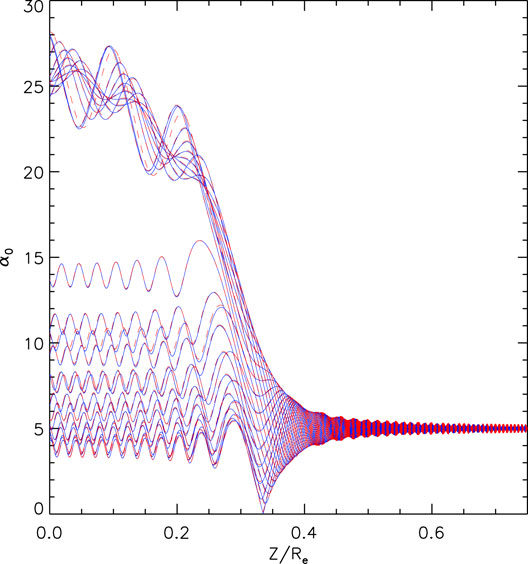
FIGURE 1. Evolution of 24 electrons starting at z/Re = 1 and interacting with a whistler mode wave, with particle and wave parameters as given in the text. Red curves show results for the equations of motion given in Eq. 2, and blue curves used Eq. 3.
Figure 2 shows results using Eq. 10 (blue) or Eq. 12 (red). The equatorial pitch angle α0 obtained from the normalized variables (I, z) via
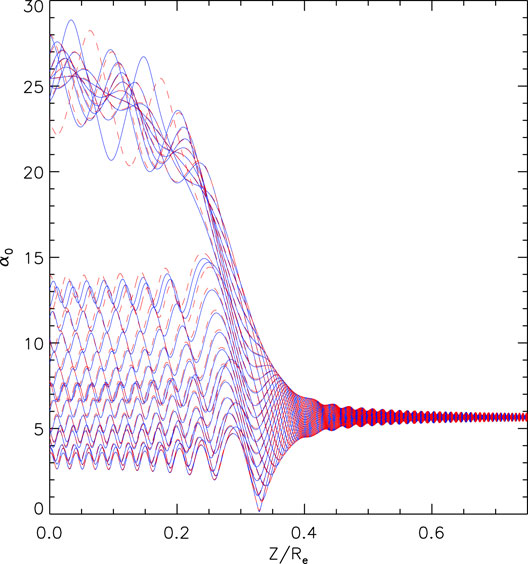
FIGURE 2. Evolution of 24 electrons starting at z/Re = 1 and interacting with a whistler mode wave, according to equations of motion based on K(I, ξ, z, t). Blue curves show results for the equations of motion given in Eq. 10, and red curves used Eq. 12.
The behavior turns out to be very similar to the previous run, with 9 instances of PT, leading to α0 ≈ 25° at z = 0, with the rest of the particles ending up with α0 spread between about 4° and 14°.
Finally, Figure 3 shows results using Eqs. 15, 18. Again the results are very similar in the final α0 values reached by PT or PPB particles, and in the number of each. The number of PT particles in this run is 8, which does not deviate much from the previous values given the small number (24) of particles in each simulation.
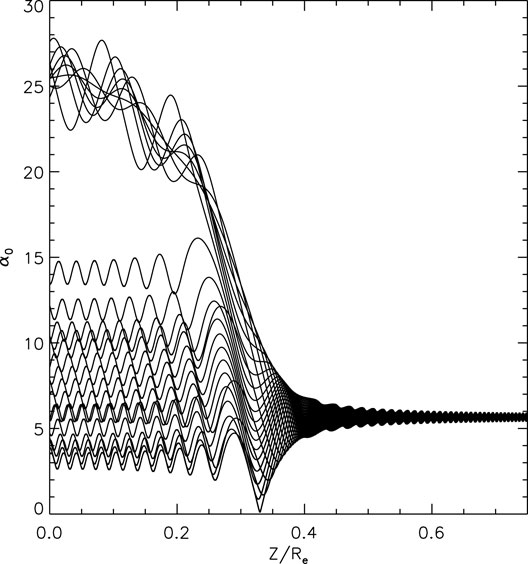
FIGURE 3. Evolution of 24 electrons starting at z/Re = 1 and interacting with a whistler mode wave, according to equations of motion based on K(I, ξ, z), namely Eqs 15, 18.
We conclude that the reduced Hamiltonian K(I, ξ, z) of Eq. 13 captures the nature of the particle dynamics, including APT and PPB, with fidelity comparable to the other models. This is propitious because it allows access to a rich body of work on invariant breaking at separatrix crossings (e.g., Cary et al., 1986), enabling both qualitative understanding and quantitative analytical estimates.
Some steps have already been taken in that direction. Figure 4 shows the results of Figure 3 in the (I, ξ) plane, with PT trajectories (identified as above) over the interval 0.4 > z > 0 shown in red, and become limited in ξ while reaching large values of I. The remaining paths, shown in blue (over the interval 0.4 > z > 0.22, for clarity), do not reach such large values of I but are less restricted in ξ. Figure 5 shows contours of K(I, ξ, z) at several fixed values of z chosen during the trapping process, based on Figure 3. They indicate that at early times (large values of z) there is only a single, O-type fixed point, while an X-point and separatrix, as well as another O-point, form around the time of the trapping process. Contours circling the O-point at ξ = π/2 correspond to the (red) PT trajectories of Figure 4, and PPB trajectories (in blue) are connected to the development of the O-point at low I and ξ = −π/2. Similar contours, developed from Eq. 13 with further approximation, were obtained and studied by Albert et al. (2021), Artemyev et al. (2021). Quantitative analysis of separatrix formation and crossing, invariant breaking, and energy and pitch angle change will be the subject of future work.
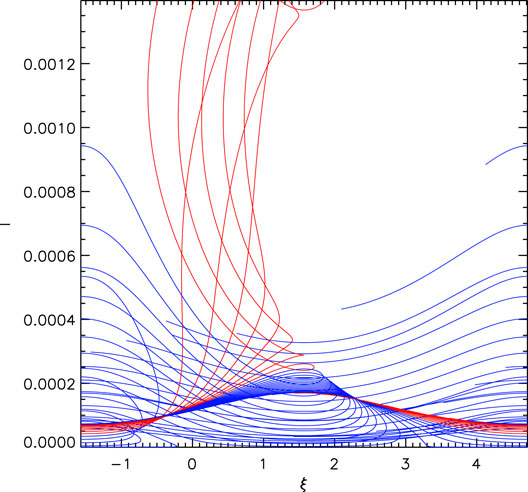
FIGURE 4. Evolution of 24 electrons interacting with a whistler mode wave, according to equations of motion based on K(I, ξ, z), shown in the (I, ξ) plane. Phase-trapped trajectories are shown for 0.4 > z/Re > 0, in red; other trajectories are shown in blue for 0.4 > z/Re > 0.22.
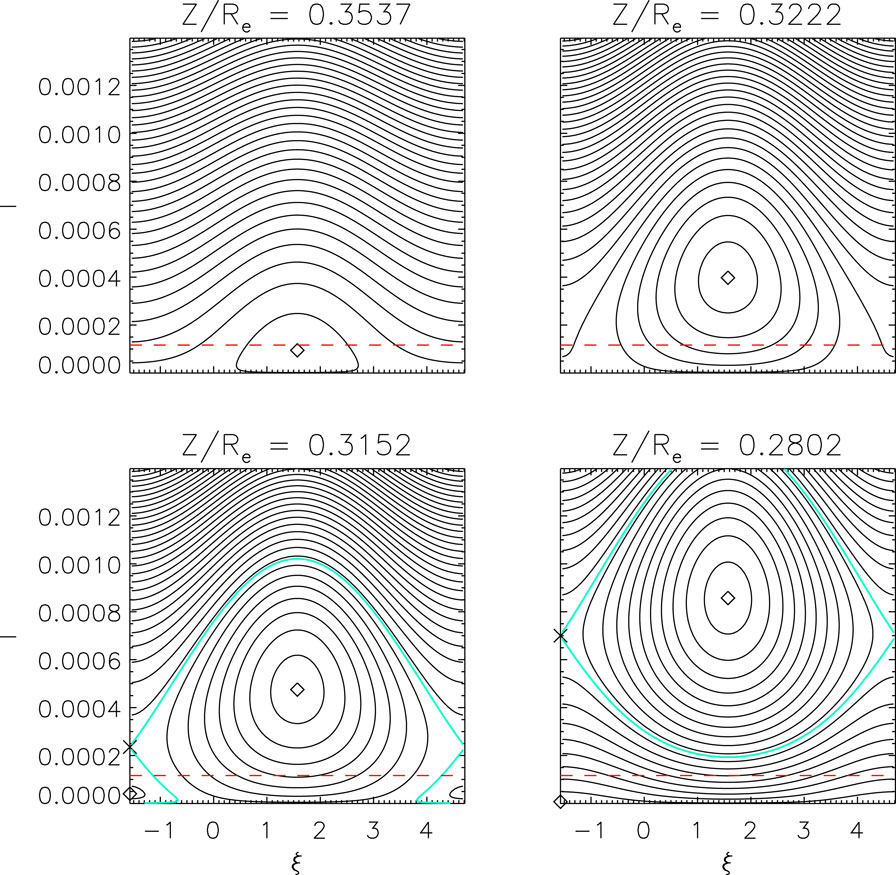
FIGURE 5. Contours of K(I, ξ, z), at several values of z shortly before and after resonance crossing, according to motion based on K(I, ξ, z). O-points are shown as diamonds, and X-points (if present) are shown with an X symbol, with the contour through them is in cyan. The red, dashed curve shows the initial value of I.
Data Availability Statement
The original contributions presented in the study are included in the article/supplementary material, further inquiries can be directed to the corresponding author.
Author Contributions
JA conceived this work, and wrote and ran the simulations. AA helped analyze approaches to reducing the dimensionality of the system of equations. WL, QM, and LG consulted on the work and made several useful suggestions on the simulations and presentation.
Funding
JA was supported by NASA grant 80NSSC19K0845 and the Space Vehicles Directorate of the Air Force Research Laboratory. WL, LG, and QM also acknowledge the NASA grants 80NSSC20K1506 and 80NSSC20K0698, NSF grant AGS-1847818, and the Alfred P. Sloan Research Fellowship FG-2018-10936.
Conflict of Interest
The authors declare that the research was conducted in the absence of any commercial or financial relationships that could be construed as a potential conflict of interest.
Publisher’s Note
All claims expressed in this article are solely those of the authors and do not necessarily represent those of their affiliated organizations, or those of the publisher, the editors and the reviewers. Any product that may be evaluated in this article, or claim that may be made by its manufacturer, is not guaranteed or endorsed by the publisher.
Acknowledgments
The views expressed are those of the author and do not reflect the official guidance or position of the United States Government, the Department of Defense or of the United States Air Force. The appearance of external hyperlinks does not constitute endorsement by the United States Department of Defense (DoD) of the linked websites, or the information, products, or services contained therein. The DoD does not exercise any editorial, security, or other control over the information you may find at these locations.
References
Albert, J. M., Artemyev, A. V., Li, W., Gan, L., and Ma, Q. (2021). Models of Resonant Wave‐Particle Interactions. J. Geophys. Res. Space Phys. 126, e2021JA029216. doi:10.1029/2021JA029216
Albert, J. M. (2001). Comparison of Pitch Angle Diffusion by Turbulent and Monochromatic Whistler Waves. J. Geophys. Res. 106, 8477–8482. doi:10.1029/2000JA000304
Albert, J. M. (1993). Cyclotron Resonance in an Inhomogeneous Magnetic Field. Phys. Fluids B Plasma Phys. 5, 2744–2750. doi:10.1063/1.860715
Albert, J. M. (2010). Diffusion by One Wave and by Many Waves. J. Geophys. Res. 115, A00F05. doi:10.1029/2009JA014732
Albert, J. M. (2000). Gyroresonant Interactions of Radiation Belt Particles with a Monochromatic Electromagnetic Wave. J. Geophys. Res. 105, 21191–21209. doi:10.1029/2000JA000008
Albert, J. M., Tao, X., and Bortnik, J. (2012). “Aspects of Nonlinear Wave-Particle Interactions,” in Dynamics of the Earth’s Radiation Belts and Inner Magnetosphere. Editor D. Summers (Washington, DC: American Geophysical Union), 255–264. doi:10.1029/2012GM001324
Allanson, O., Elsden, T., Watt, C., and Neukirch, T. (2022). Weak Turbulence and Quasilinear Diffusion for Relativistic Wave-Particle Interactions via a Markov Approach. Front. Astron. Space Sci. 8, 805699. doi:10.3389/fspas.2021.805699
Artemyev, A. V., Neishtadt, A. I., Albert, J. M., Gan, L., Li, W., and Ma, Q. (2021). Theoretical Model of the Nonlinear Resonant Interaction of Whistler-Mode Waves and Field-Aligned Electrons. Phys. Plasmas 28, 052902. doi:10.1063/5.0046635
Artemyev, A. V., Neishtadt, A. I., Vainchtein, D. L., Vasiliev, A. A., Vasko, I. Y., and Zelenyi, L. M. (2018). Trapping (Capture) into Resonance and Scattering on Resonance: Summary of Results for Space Plasma Systems. Commun. Nonlinear Sci. Numer. Simul. 65, 111–160. doi:10.1016/j.cnsns.2018.05.004
Bell, T. F. (1984). The Nonlinear Gyroresonance Interaction between Energetic Electrons and Coherent VLF Waves Propagating at an Arbitrary Angle with Respect to the Earth's Magnetic Field. J. Geophys. Res. 89, 905–918. doi:10.1029/JA089iA02p00905
Cary, J. R., Escande, D. F., and Tennyson, J. L. (1986). Adiabatic-Invariant Change Due to Separatrix Crossing. Phys. Rev. A 34, 4256–4275. doi:10.1103/PhysRevA.34.4256
Chang, H. C., and Inan, U. S. (1983). Quasi-Relativistic Electron Precipitation Due to Interactions with Coherent VLF Waves in the Magnetosphere. J. Geophys. Res. 88, 318–328. doi:10.1029/ja083iA01p00318
Gan, L., Li, W., Ma, Q., Albert, J. M., Artemyev, A. V., and Bortnik, J. (2020). Nonlinear Interactions between Radiation Belt Electrons and Chorus Waves: Dependence on Wave Amplitude Modulation. Geophys. Res. Lett. 47, e2019GL085987. doi:10.1029/2019GL085987
Ginet, G. P., and Albert, J. M. (1991). Test Particle Motion in the Cyclotron Resonance Regime. Phys. Fluids B 3, 2994–3012. doi:10.1063/1.859778
Ginet, G. P., and Heinemann, M. A. (1990). Test Particle Acceleration by Small Amplitude Electromagnetic Waves in a Uniform Magnetic Field. Phys. Fluids B 2, 700–714. doi:10.1063/1.859307
Inan, U. S., Bell, T. F., and Helliwell, R. A. (1978). Nonlinear Pitch Angle Scattering of Energetic Electrons by Coherent VLF Waves in the Magnetosphere. J. Geophys. Res. 83, 3235–3253. doi:10.1029/ja083iA07p03235
Kitahara, M., and Katoh, Y. (2019). Anomalous Trapping of Low Pitch Angle Electrons by Coherent Whistler Mode Waves. J. Geophys. Res. Space Phys. 124, 5568–5583. doi:10.1029/2019JA026493
Lemons, D. S., Liu, K., Winske, D., and Gary, S. P. (2009). Stochastic Analysis of Pitch Angle Scattering of Charged Particles by Transverse Magnetic Waves. Phys. Plasmas 16, 112306. doi:10.1063/1.3264738
Lemons, D. S. (2012). Pitch Angle Scattering of Relativistic Electrons from Stationary Magnetic Waves: Continuous Markov Process and Quasilinear Theory. Phys. Plasmas 19, 012306. doi:10.1063/1.3676156
Li, J., Bortnik, J., Xie, L., Pu, Z., Chen, L., Ni, B., et al. (2015). Comparison of Formulas for Resonant Interactions between Energetic Electrons and Oblique Whistler-Mode Waves. Phys. Plasmas 22, 052902. doi:10.1063/1.4914852
Liu, K., Lemons, D. S., Winske, D., and Gary, S. P. (2010). Relativistic Electron Scattering by Electromagnetic Ion Cyclotron Fluctuations: Test Particle Simulations. J. Geophys. Res. 115, A04204. doi:10.1029/2009JA014807
Liu, K., Winske, D., Gary, S. P., and Reeves, G. D. (2012). Relativistic Electron Scattering by Large Amplitude Electromagnetic Ion Cyclotron Waves: The Role of Phase Bunching and Trapping. J. Geophys. Res. 117, A06218. doi:10.1029/2011JA017476
Lyons, L. R., Thorne, R. M., and Kennel, C. F. (1971). Electron Pitch-Angle Diffusion Driven by Oblique Whistler-Mode Turbulence. J. Plasma Phys. 6, 589–606. doi:10.1017/S0022377800006310
Lyons, L. R., Thorne, R. M., and Kennel, C. F. (1972). Pitch-Angle Diffusion of Radiation Belt Electrons within the Plasmasphere. J. Geophys. Res. 77, 3455–3474. doi:10.1029/JA077i019p03455
Shklyar, D. R. (1986). Particle Interaction with an Electrostatic vlf Wave in the Magnetosphere with an Application to Proton Precipitation. Planet. Space Sci. 34, 1091–1099. doi:10.1016/0032-0633(86)90021-8
Thorne, R. M., Li, W., Ni, B., Ma, Q., Bortnik, J., Chen, L., et al. (2013). Rapid Local Acceleration of Relativistic Radiation-Belt Electrons by Magnetospheric Chorus. Nature 504, 411–414. doi:10.1038/nature12889
Keywords: wave-particle interactions, radiation belts, nonlinear, Hamiltonian, test particle simulation
Citation: Albert JM, Artemyev A, Li W, Gan L and Ma Q (2022) Equations of Motion Near Cyclotron Resonance. Front. Astron. Space Sci. 9:910224. doi: 10.3389/fspas.2022.910224
Received: 01 April 2022; Accepted: 06 May 2022;
Published: 16 June 2022.
Edited by:
Yuri Y. Shprits, GFZ German Research Centre for Geosciences, GermanyReviewed by:
Peter Haesung Yoon, University of Maryland, United StatesXin Tao, University of Science and Technology of China, China
Copyright © 2022 Albert, Artemyev, Li, Gan and Ma. This is an open-access article distributed under the terms of the Creative Commons Attribution License (CC BY). The use, distribution or reproduction in other forums is permitted, provided the original author(s) and the copyright owner(s) are credited and that the original publication in this journal is cited, in accordance with accepted academic practice. No use, distribution or reproduction is permitted which does not comply with these terms.
*Correspondence: Jay M. Albert, amF5LmFsYmVydEB1cy5hZi5taWw=
 Jay M. Albert
Jay M. Albert Anton Artemyev
Anton Artemyev Wen Li
Wen Li Longzhi Gan
Longzhi Gan Qianli Ma
Qianli Ma